
Pizza and Best Practices for Agile and DevOps Adoption
[ad_1]
When I think about the challenges of digital business and the need to innovate quickly while reducing risk and delivering the perfect customer experience, pizza comes to mind. And it’s not just because I’m hungry. Consider how pizza has transformed over the years from the basic options of just a cheese or pepperoni pizza to complete meals that can include 8 more of the trendiest toppings of your choice. (If it were up to me, I’d say that adding jalapenos is essential but no anchovies are allowed). And the options don’t end there – ordering pizza is becoming an art: What crust do you want? Do you want anything on your crust or baked into your crust? Red sauce, green sauce or white sauce (yes, alfredo on pizza)? Or, perhaps you’d like a cheese blend rather than traditional mozzarella? And, naturally, you don’t want to wait. Delivery should be in 15 minutes or less. If you’re dining out, it’s considered a quick meal – a good option if you are headed to a movie afterwards. To stay competitive, many of the leading pizza restaurants focus on innovation in the quest for the perfect slice that must taste better, give customers more options, still be affordable, reduce risk (no burnt pizza allowed unless you request it that way), and be delivered ASAP.
Now, it’s time to stop salivating and consider how this emphasis on innovation and customer satisfaction to improve business results for pizza also applies to application development and delivery (AD&D) and DevOps teams. These teams must also focus on quickly innovating and delivering great customer experiences. Agile and DevOps best practices can make that possible with processes, tools, and approaches for software and applications while reducing risk. By embedding workflow scheduling into the development process, these teams can help ensure success.
Agile + DevOps + Automated job scheduling = The Perfect recipe
A new Forrester report based on a survey of more than 28,000 customers, described the powerful combination of Agile principles and DevOps, and how application innovation and speed can impact the bottom line. They developed a formula to determine the Customer Experience Index™ and explained how a one point improvement in this index can drive revenue. As an example, for luxury auto makers this improvement can add up to an annual incremental revenue per customer of $337.10. When you multiply that times an average of 350,000 customers per company, it equates to an extra $118 million per company per year. Wow! For wireless providers, this equates to an extra $2.13 per customer per year. That may not sound like much but since the average number of customers per wireless company surveyed was 82 million, this added up to $175 million per company per year.1 Now that’s a nice slice of the pie!
Follow the playbook for faster, better, higher-quality applications
In the report, Forrester developed a modern application delivery playbook based on the following best practices: Discover, Plan, Act, and Optimize. Here are some highlights:
- Discover: Improve application delivery for competitive differentiation.
- Plan: Deliver small but consistent incremental steps for improvement, which includes developing in small batches, utilizing continuous integration, employing API-driven testing, and more.
- Act: Eliminate wait times and hand-offs and use tools to help automate, manage, and deploy software continuously and provide faster delivery.
- Optimize: Continually improve products and processes to stay ahead of the competition. Focus on standardizing with automation to reduce the risk of manual errors while improving the speed of delivery.
What can your organization do to make it easier for AD&D and DevOps teams to meet these objectives? Consider the Control-M enterprise workload automation solution, which controls and coordinates workflows. Having a solution that provides a centralized approach for scheduling makes it easy to follow these best practices. Control-M provides self-service for job scheduling and gives developers more control to deal with the increased complexity of the cloud, big data, and digital business growth and other challenges. With the Control-M Automation API, for example, developers and DevOps engineers can integrate what they want and do this easily and quickly to deliver apps faster to win, serve, and retain customers while reducing costs and risk.
Read the Forrester report, Agile and DevOps Adoption Drives Digital Business Success, to learn more. Then think about what you’d like to add to your next slice of pizza.
1Forrester: Agile and DevOps Adoption Drives Digital Business Success, November 16, 2016 ↩
Forrester: Agile & DevOps Adoption Drive Digital Business Success

In this Forrester report, you’ll learn how you can modernize your digital business with Agile and DevOps best practices.
[ad_2]
Source link
